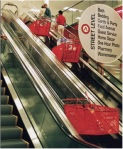A Placemaking Journal
Retail Redemption: Skivvies Uncovered, then Promptly Covered
A couple months ago I rambled on here about my inability to purchase a particularly critical item of men’s apparel during an extended tour of new urban projects throughout the southeast. Modesty was not my problem. Rather, despite healthy commercial activity most everywhere I went, I could find no walkable stores catering to such day-to-day basics.
Food and drink? Sure. Tchotchkes and novelties? You betcha. Skivvies? Not a chance.
By the end of the trip, the sad reality of neighborhood retail staples was more than a little exposed. As was I. So when an equally hectic SmartCode education tour through the mid Atlantic states had us back out on the road recently, my colleague, Nathan R. Norris, took the opportunity — leading me through his boyhood home of Washington DC, then out the Metro line to Columbia Heights — to convince me all was not lost.
Escalating up to the corner of 17th and Irving, we crossed a busy plaza and narrow street to the Target store, located on the floors above Marshall’s, Best Buy, and Bed Bath and Beyond. Once in Target, we loaded our shopping cart onto the Cartovator and, heading upstairs one more time, found ourselves in the Men’s Clothing section on the third floor.
And there, success. In every conceivable style, size and comfort level. New Urbanism had worked its magic again.
Columbia Heights, a 2009 ULI Award for Excellence and CNU Charter Award winner, was severely blighted a few years ago. Today, however, there are about three square blocks of newly constructed multi-story shopping, office, grocery and residential buildings oriented around the Green line Transit station. The older Mount Pleasant neighborhood surrounding the new TOD Station Area is a robust mix of townhouses and live work units. On the beautiful Saturday afternoon of our visit, the new plaza was abuzz with a farmers market and a wealth of outdoor dining tables all fully occupied.
The key to Columbia Heights was that Torti Gallas and Partners expertly leveraged its transit station location to reconfigure conventional big box retailers into urban amenities that support plazas, and both expensive and discount shopping opportunities within walking distance of high-intensity residential areas.
Retail is an interesting canary to observe during this Great Recession. In response to expensive cash and cheaper land, a new temporary urban retail format is hitting the streets. In Hercules, California, The Red Barn Company has unveiled its new Market Hall, which was slated to be built-out as a new downtown. However, with the recent difficulty in financing delaying their start, Partner Tom Weigle and designer AJ Remen have repurposed a parking lot into a temporary mixed-use gathering space.
Through creative design and permitting on a one-acre parcel, there’s now retail shopping in containers that front a plaza and dining in travel trailers surrounding a green, accommodating weekend bazaars, farmers markets and evening movie events. Active and successful, it’s creating a local buzz, not to mention political will for the future four acres of buildings for dining, shopping, and public spaces with housing.
Yes, the learning curve has been expensive, as usual, but now the Hercules Market Hall concept is being considered by other California projects as an effective means of bringing empty lots into use while their potential as downtowns of their own waits on the cornerstones of market and financing to work out their differences.
–Howard Blackson











